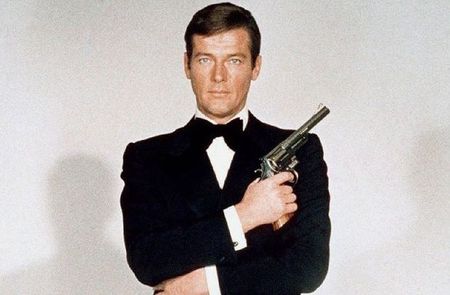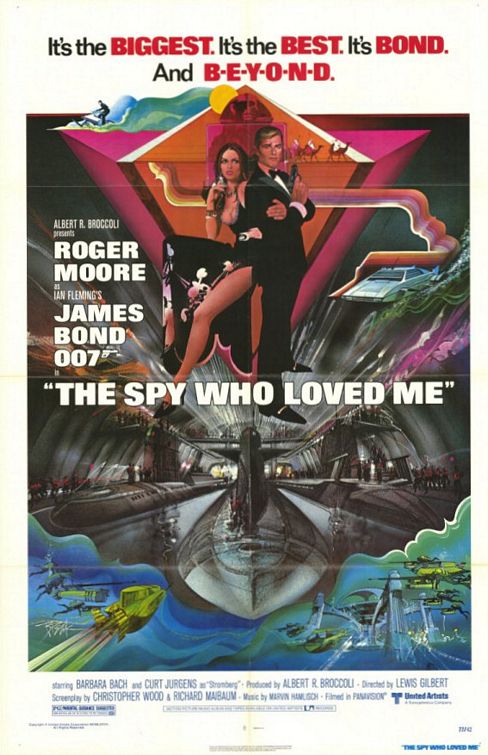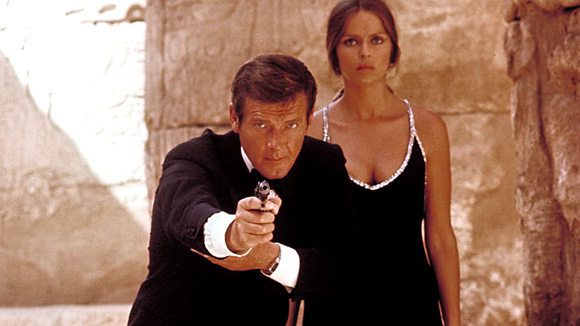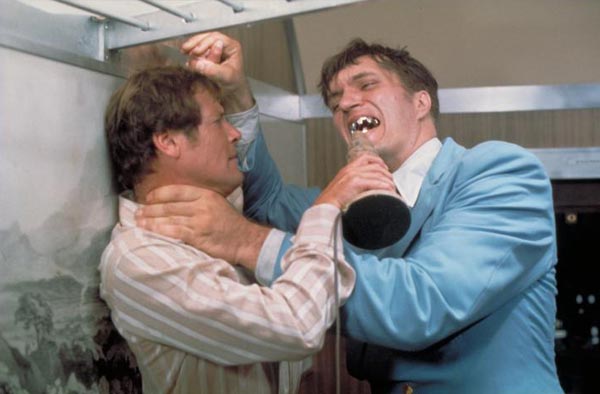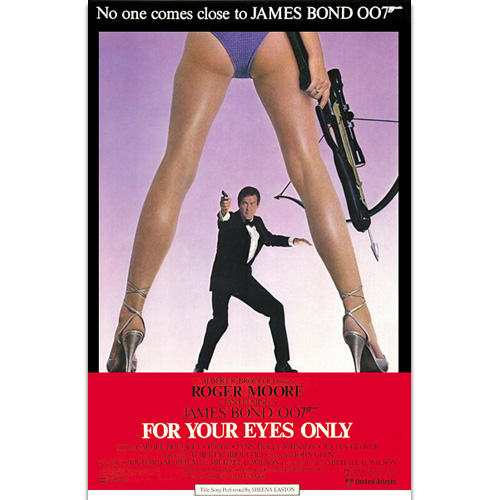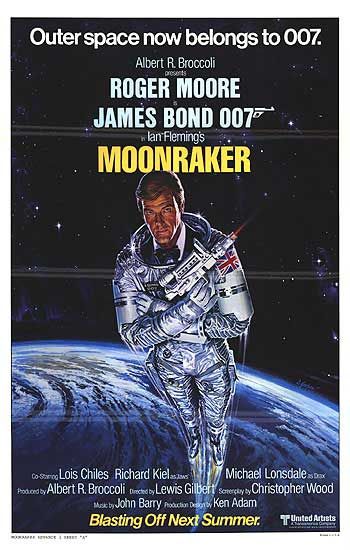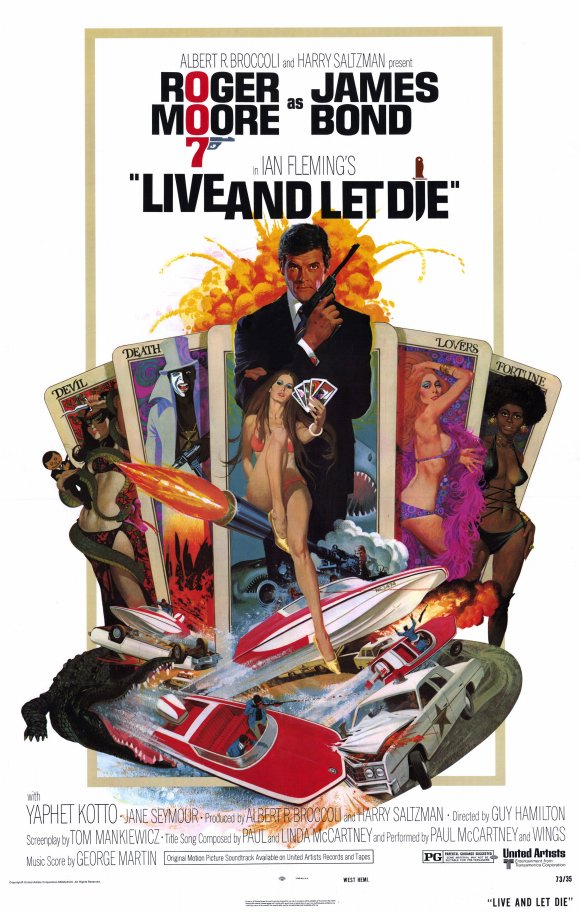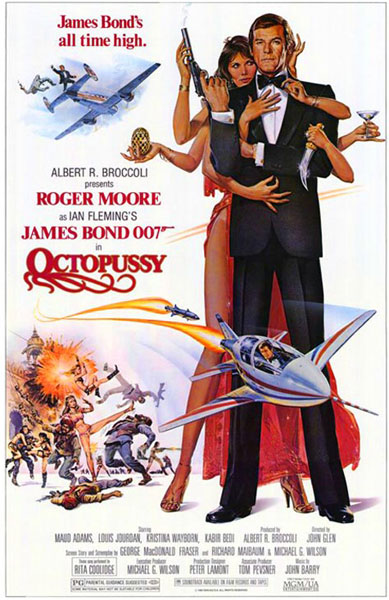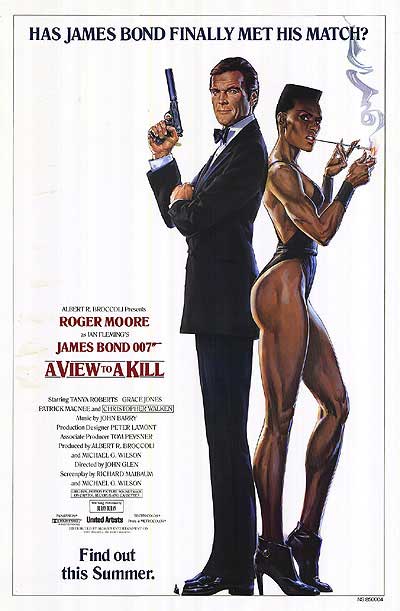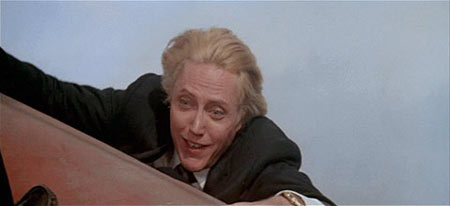Well, maybe as a debonair Englishman, a knight of the realm and for his charity work, he did. But in a stadium full of Bond fans, there’d be crickets when asking for a hurrah from those who think Moore was the best Bond.
While I don’t know that I’d be the one to break the silence, he was my childhood Bond, and as such I have a soft spot for the guy. He wasn’t as hard or cool as Connery, and during his stint the series descended into almost a parody of itself, but when I think of James Bond, the movies he starred in are the first that come to mind. And he did have a great sense of grace and style (’70s pantsuits!), and a way with a quip.
As with the Connery-era reviews, I start with my favourites and work my way down to the lesser entries. You can also find Dalton, Brosnan, Craig, and even Lazenby reviews on this blog.
The Spy Who Loved Me (1977) | Directed by Lewis Gilbert | Written by Christopher Wood and Richard Maibaum | 125 min
Probably more than any of the Bond movies, except maybe Goldfinger, The Spy Who Loved Me has the most… Bond-ness… if that is a word. It’s a combination of elements that just makes it pop. It’s also about scale. An entire new soundstage at Pinewood Studios in the UK was built to accommodate the tanker interior for the explosive finale.
This, the third outing for Moore as Bond, got almost everything right. A shipping magnate named Stromberg (Curd Jurgens) plans to destroy civilization and restart human life beneath the waves. His mad plan uses nuclear weapons stolen from British and American submarines swallowed up in a gigantic oil tanker. (It’s not so different from the spaceship in You Only Live Twice swallowing other, smaller orbiting ships.) Stromberg lives on a peculiar platform off Sardinia, which Bond visits pretending to be an oceanographer.
Giving a bit more depth to the film’s romantic content is the frisson between Bond and Major Anya Amasova aka Agent XXX (Barbara Bach), a Russian spy. They’re forced to team up to solve the case of the missing subs, but what she doesn’t know is that during the dynamite pre-credit sequence, Bond killed her lover while skiing down a mountain (and eventually parachuting off a cliff, one of the great stunts ever in the history of movies, let alone this franchise). She figures it out eventually, and then the question becomes whether she’ll kill Bond herself or be seduced by him. No bets on that one.
The Spy Who Loved Me is also notable for providing Bond with his second truly iconic automobile: the white Lotus Esprit, a British-made, Q Branch-customized sports car that, naturally, is as versatile in the water as it is on land.
And then there’s the best evil henchman in all Bond movies, and the only one ever who lives to worry Bond again in a subsequent movie: Jaws (Richard Kiel)…
…a giant of a man with steel dentures. Jaws is almost as terrifying as his fishy namesake.
For Your Eyes Only (1981) | Directed by John Glen | Written by Richard Maibaum and Michael G. Wilson | 127 min
There’s a darkness in this edition of Bond, one that becomes it. It starts with the pre-credit sequence, a bit of unfinished business that reconnects the franchise with an earlier era: Bond — a visibly aging Moore, but he’s not yet so long in the tooth that his action sequences are ridiculous — is paying respects at the grave of his wife (see On Her Majesty’s Secret Service) when he’s interrupted by a remote-controlled helicopter under the command of Blofeld himself, even if he’s not identified as such. (To this point, the Moore films have been a SPECTRE-free zone.) Bond does manage to dispatch his nemesis, evidently for the final time.
The film is a leaner model than either of the previous couple movies, with a much simpler plot in comparison. A freighter in the Mediterranean is hiding some pretty high-tech British military equipment, including a computer MacGuffin called ATAC used to communicate and track the British submarine fleet. The ship strikes a WWII relic mine and sinks. The Brits contract a marine archeologist to find the wreck, but he’s murdered by a Cuban assassin. The Soviets want the ATAC, but is there a third party also on the hunt? Bond will figure it out, no doubt, with the help of the archeologist’s daughter, Melina (intense and gorgeous French thesp Carole Bouquet), who is looking for revenge. Locations include Italy, Greece, Spain and the UK.
We get another excellent chase on skis, another nasty assassin, the entirely silent Emile Leopold Locque (Michael Gothard), and a ditsy but precocious figure skater, Bibi (Lynn-Holly Johnson), who Bond actually turns down for being too young. (I was shocked, too!) And there’s a third-act reveal of Topol as Columbo, a Greek smuggler who helps Bond infiltrate villain’s hideout that serves as the most unusual finale locale for a Bond movie, a mountain-top monastery.
Overall, the vibe leans a bit more to realism than bombast. For the first time since the Connery era we get a film that feels like a real spy thriller. If The Spy Who Loved Me is akin to Goldfinger, then For Your Eyes Only has some of the spirit of From Russia With Love.
Random Thoughts:
The opening 20 minutes—from the pre-credit sequence, the sinking of the St Georges and the death of the Havelocks—are some of the best scenes in a Bond movie ever. Right up to where Bond and Melina meet, and the cheesy disco soundtrack kicks in and they get into the canary-yellow Citroen 2CV. That said, Bouquet is the best “Bond Girl” since Diana Rigg, and is an unflappable, stone cold killer. Also too young for Moore, but that isn’t new.
“You were meant to question Gonzalez, not let Miss Havelock perforate him!” Great line.
Another ski scene, another similarity with On Her Majesty’s Secret Service, except this time he’s in Italy, Cortina d’Ampezzo, not the Swiss Alps. Otherwise it isn’t all that special.
They never really explain why they leave the SCUBA gear at the submerged temple. Or why Melinda is the only one who could decipher her father’s shorthand. Both turn out to be conveniently useful, mind you.
The submerged St Georges set is amazing, as is the approach of the guy in the giant diving suit. Very Jaws-inspired. (The shark movie, not the steel-tooth villain.)
Unfortunately, the St Cyrils mountaintop monastery stuff is mostly shot in studio and is distractingly fake. But I still love the finale, which undermines the usual Bond bombast.
(The Maggie and Dennis Thatcher scene at the very end is inexcusable, mind you.)
Moonraker (1979) | Directed by Lewis Gilbert | Written by Christopher Wood | 126 min
Moonraker has been criticized as being hurried into production to capitalize on all things space-related, given the success of Star Wars. That may have been the inspiration, but the film, while more than a little silly, is still jam-packed with entertainment.
Plot-wise it’s not such a departure from The Spy Who Loved Me; another megalomaniacal gazillionaire, Hugo Drax (Michael Lonsdale), this one involved in space shuttle manufacture who actually wants to erase humanity and replace it with “genetically pure” Aryan couples. Highlights include a double-entendre character name so rich it’s practically a single-entendre: Dr. Holly Goodhead (Lois Chiles), an American astronaut/scientist who is secretly working for the CIA. We get a free-fall pre-credit sequence that seems to defy at least a couple laws of physics. Best of all is the return of the monstrous killer named Jaws, who in a strange twist experiences a bit of a change of heart, even after making such a great effort to kill Bond on a Rio De Janeiro cable-car.
And yes, there’s a finale that takes place on a large orbiting satellite, complete with a laser gun battle and cheesy laser gun battle effects. But it all sets up for Q’s classic line, “I believe he’s attempting reentry….” Yup, it’s fromage, but nobody does it better.
Live and Let Die (1973) | Directed by Guy Hamilton | Written by Tom Mankiewicz | 121 min
This is one weird Bond movie, a Bond picture/blaxploitation amalgam. If there’s a mash-up that shouldn’t work: Bond and Superfly. And, to be honest, it doesn’t. But it’s so peculiar for Bond it keeps your attention, combining Harlem gangster sequences, campy voodoo, one-armed henchmen, and a lot of cultural insensitivity, if not outright racism.
The first film to star Roger Moore as Bond, the plot has 007 investigating the death of an MI6 agent in New Orleans, a New York drug kingpin, Mr Big, and the ruler of a (fictional) small Caribbean island called San Monique, a guy named Dr Kananga (Yaphet Kotto). Of course, there’s a woman involved, a tarot card reader named Solitaire (Jane Seymour), and a voodoo priest named Baron Samedi (Geoffrey Holder, who went on to a career as a 7-Up pitchman, amongst other things).
There’s a great boat chase in the Louisiana swamps, alligators, and the unfortunate inclusion of a broad redneck character named Sheriff J.W. Pepper, who, despite his reappearance in The Man With The Golden Gun, we won’t ever mention again, OK?
Probably the most memorable thing about Live and Let Die was the song by Paul McCartney and Wings. Still awesome.
Octopussy (1983) | Directed by John Glen | Written by George MacDonald Fraser, Richard Maibaum and Michael G. Wilson | 131 min
A convoluted and over-long Bond film, but not without a few incidental pleasures. The plot has Bond chasing Faberge Eggs and bad men in India and East Germany. Of course there’s a nuclear weapon and a tense scene to defuse it. The film has another excellent pre-credit sequence involving a pocket-sized jet, but is mostly remembered for being the first in the series where the wacky, sexualized name of the female lead (played by Maud Adams—twice a “Bond Girl”, actually, she was in The Man With The Golden Gun) was also the title of the film. Moore really starts to look uncomfortably stiff in the action sequences here, and probably should have turned in his licence to kill following For Your Eyes Only.
The Man With the Golden Gun (1974) | Directed by Guy Hamilton | Written by Richard Maibaum and Tom Mankiewicz | 125 min
A professional hitman named Scaramanga (Christopher Lee), who charges a million dollars a hit using a gun made from a golden lighter, cigarette case and pen, takes a personal interest in James Bond. That’s basically the crux of the movie, with added solar weapons and kung-fu thrown into the mix. Yes, this is another mash-up of sorts, and again it’s a bit of a weird idea, capitalizing on the public’s interest in Bruce Lee, I suppose. The kung-fu is, unfortunately, half-baked, but the Thailand locations are gorgeous, an MI:6 base in the rusty hulk of the Queen Elizabeth II in Hong Kong harbour is a cool idea, there’s a great car jump stunt with an AMC Hornet, and Hervé Villechaize makes a compelling henchman. But this is really Lee’s movie. Rarely has a villain in these movies been a genuine nemesis for Bond, in every way his equal.
A View To A Kill (1985) | Directed by John Glen | Written by Richard Maibaum and Michael G. Wilson | 131 min
One of the weakest in the franchise, a lugubrious mess with next to no forward momentum in the plot, which has something to do with Silicon Valley computer chips, breeding racehorses, an enormous bomb, and I don’t even know what. It’s all pointlessly convoluted, and not in the usual, cool way. Moore is in his late 50s and looks way too frail to be chasing around, say, Paris, driving French cars that get cut in half on the boulevards along the Seine. The presence of toffee-nosed Patrick Macnee connects Bond to that other great British TV spy series The Avengers, and flamboyant villains Christopher Walken and Grace Jones both manage to inject a bit of fun into the proceedings. Check out Walken’s expression when his character, Zorin, is facing death:
But, aside from that and the ’80s pop classic title song from Duran Duran, there’s not much else to recommend it.
I’ve also written up my thoughts on the Sean Connery era, On Her Majesty’s Secret Service, the Timothy Dalton era, the Pierce Brosnan era, and Daniel Craig.





